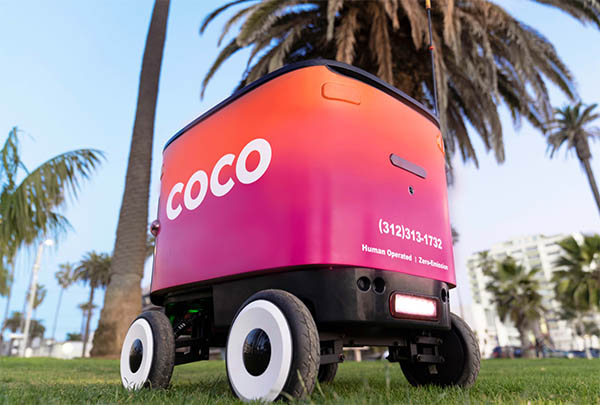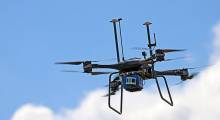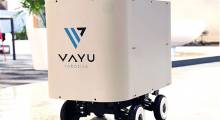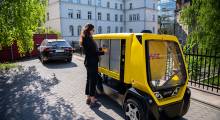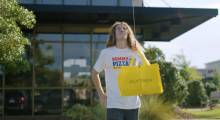Even as the COVID-19 pandemic abates, restaurants are coming under new pressure, as rising gas prices affect the cost of food and third-party delivery services. More eateries are turning to robot deliveries from providers such as Coco from Cyan Robotics Inc.
Coco has been working with C3 by SBE, short for Creating Culinary Communities, which is held by SBEEG Holdings Licensing LLC or SBE, a Brooklyn, N.Y.-based operator of hotels, restaurants, and nightclubs worldwide. C3 is also working with Nommi, which has developed bowl-assembling robots.
The global market for delivery robots could expand from $100.8 million in 2021 to $262.7 million by 2027 at a compound annual growth rate (CAGR) of 17.31%, according to Astute Analytica. With Motional and Uber Eats starting testing of autonomous vehicle deliveries in Santa Monica, Calif.; Cleveron beginning last-mile deliveries in Estonia; and Teksbotics and Alshrouk piloting robot deliveries in Saudi Arabia, interest is growing worldwide.
Coco recently expanded service using its COCO 1 robots from Los Angeles to Houston and Austin, Texas. Joey Simons, senior vice president of operations at C3, shared insights on the growing food-on-demand market with Robotics 24/7.
C3 and Coco expanding nationwide
Given the rapid growth in interest in food-service robotics, how is Coco scaling up to meet demand? How many mobile robots do you have in the field?
Simons: Delivery experienced a massive demand boom during the pandemic, while traditional car-based delivery services simultaneously experienced driver shortages. Food delivery apps have struggled to mitigate this problem.
With Coco, however, we found a reliably available on-demand delivery partner. Coco's robots are deployed to C3 locations each morning and are allocated dynamically throughout the day. This ensures robots are always waiting and ready for immediate delivery, even during peak hours. We work with Coco to determine how many robots to deploy at each C3 location, depending on fluctuating delivery demand.
Coco constantly adapts to improve the delivery experience based on real-world learnings with C3. It's exciting to watch this technology grow and evolve based on insights gained through our partnership, which ultimately benefits our staff and customers.
We're also looking forward to watching Coco's rapid expansion across the country. The company currently has a 1,000+ robot fleet in Santa Monica, Los Angeles, Austin, and Houston, with launches in other major cities on the horizon.
How is the current gas price spike similar to the early stages of the COVID-19 pandemic, and how is it different, in terms of e-commerce?
Simons: Similar to the pandemic, the rising gas prices are leaving more consumers looking for ways to dine at their favorite restaurants with convenience top of mind while ordering in is continuing to be all the rage for friends, family, or even intimate dinner dates.
C3’s proprietary app, GO by Citizens, is seeing this with a 118% year-over-year increase in the number of orders placed.
On the flip side, the rising gas prices are creating an overall uptick in inflation, with the cost of dining, shopping, and living increasing. This switch in e-commerce is creating an interesting landscape for industries essential to people.
While kitchens and eateries are struggling for staff, who manages Coco's robot fleets?
Simons: Coco is an end-to-end service provider that manages the robots at every stage, freeing C3's staff to focus on preparing high-quality food and providing an excellent customer experience. Coco's employees handle fleet operations, robot deployment, inspections and maintenance, and even drive the orders to customers via remote piloting software.
C3 employees are only responsible for loading orders into the robots. Coco truly cares about making delivery as smooth and seamless as possible for our staff.
Restaurants and robots offer rapid response
What can a robotics provider like Coco do with C3's ghost kitchens that conventional restaurants can't?
Simons: Our partnership with Coco extends to a number of C3's digital restaurant brands. With this, consumers within two miles of the kitchens on Broadway and Main Street in Santa Monica and The Grove in West Hollywood will be able to receive their food fresh.
We’ve seen more streamlined kitchen operations, reduced costs for merchants and customers, consistent quality of food, delivery times, customer experience, and improved sustainability. Additionally, orders with Coco Delivery on average are around 10 minutes faster compared with human delivery.
How does C3's responsiveness to changing customer tastes help Coco gain market share?
Simons: C3 is a rapidly growing digital-restaurant ecosystem at the forefront of innovation. Partnering with Coco – a fellow technologically advanced industry disruptor – was a natural fit and flourished into a strong, symbiotic partnership. Our compelling success story demonstrates Coco's strengths and impact through measurable, real-world data points that the company can share with other enterprise groups.
Restaurant chains can look to our partnership as a case study on how Coco alleviates the pain points of modern delivery at scale. We hope our success encourages other restauranteurs to partner with Coco, and we look forward to continuing to roll out Coco's delivery service across our brands and locations.
Robot deliveries grow with government consultation, more partners
How does Coco deal with the mix of local regulations governing delivery robot operations?
Simons: Coco works closely with government officials at both the city and state levels to receive proper approval and permits before operating in a new market. The company establishes strong relationships with city leaders, community groups, and local businesses everywhere it operates and ensures open, trustworthy communication.
It also submits regular reports, shares data and follows all community engagement requirements in each active market. Many cities and states already have regulations governing robot delivery. Coco ensures that it fully complies with or exceeds all existing requirements in these locations.
In markets without existing robot delivery regulations, Coco works with government officials to draft legislation that will ensure safe operations within the local community. For example, the company worked directly with the LA Department of Transportation to develop a formal program for personal delivery devices in the city.
What are your goals for this year, and how dependent are they on things like gas prices?
Simons: In 2022, our goal is to make C3 a household name and a go-to ordering option for consumers across the country. With inflation on the rise, from gas to food prices, one of C3’s main goals is to democratize the fine dining experience and introduce notable culinary figures to a larger audience.
Accessibility and delivering elevated experiences in a convenient way are pillars for C3. Our goals won’t necessarily be dependent on things like inflation or rising gas prices, but they will be informants for how we shift our business model to be as successful and adaptive as possible.
Are you working with other chains or companies?
Simons: In addition to our work with Coco, C3 currently has more than 40 culinary brands including Umami Burger, Sam’s Crispy Chicken, Krispy Rice, Sa’Moto, Cicci di Carne, El Polle Verde, Kumi, In a Bun, and more.
We’ve launched strategic partnerships with chains including TGI Fridays and Hooters to feature C3’s brands in their kitchens. Alongside this, we’re working to reinvigorate underutilized kitchen space in hotels including Graduate, Highgate, and more.
About the Author
Follow Robotics 24/7 on Linkedin
Article topics
Email Sign Up

